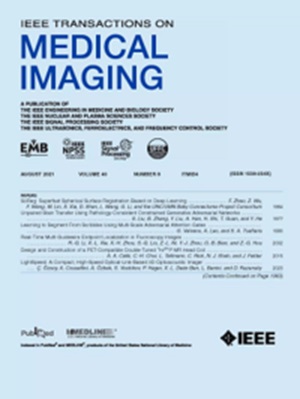LViT: Language meets Vision Transformer in Medical Image Segmentation
IF 8.9
1区 医学
Q1 COMPUTER SCIENCE, INTERDISCIPLINARY APPLICATIONS
引用次数: 22
Abstract
Deep learning has been widely used in medical image segmentation and other aspects. However, the performance of existing medical image segmentation models has been limited by the challenge of obtaining sufficient high-quality labeled data due to the prohibitive data annotation cost. To alleviate this limitation, we propose a new text-augmented medical image segmentation model LViT (Language meets Vision Transformer). In our LViT model, medical text annotation is incorporated to compensate for the quality deficiency in image data. In addition, the text information can guide to generate pseudo labels of improved quality in the semi-supervised learning. We also propose an Exponential Pseudo label Iteration mechanism (EPI) to help the Pixel-Level Attention Module (PLAM) preserve local image features in semi-supervised LViT setting. In our model, LV (Language-Vision) loss is designed to supervise the training of unlabeled images using text information directly. For evaluation, we construct three multimodal medical segmentation datasets (image + text) containing X-rays and CT images. Experimental results show that our proposed LViT has superior segmentation performance in both fully-supervised and semi-supervised setting. The code and datasets are available at https://github.com/HUANGLIZI/LViT.医学图像分割中语言与视觉转换器的结合
深度学习在医学图像分割等方面得到了广泛的应用。然而,现有医学图像分割模型的性能一直受到数据标注成本过高而无法获得足够高质量标记数据的挑战的限制。为了缓解这一限制,我们提出了一种新的文本增强医学图像分割模型LViT (Language meets Vision Transformer)。在我们的LViT模型中,医学文本注释被纳入以弥补图像数据的质量缺陷。此外,在半监督学习中,文本信息可以引导生成质量提高的伪标签。我们还提出了一种指数伪标签迭代机制(EPI)来帮助像素级注意模块(PLAM)在半监督LViT设置下保持局部图像特征。在我们的模型中,LV (Language-Vision)损失被设计用来直接使用文本信息监督未标记图像的训练。为了评估,我们构建了包含x射线和CT图像的三个多模态医学分割数据集(图像+文本)。实验结果表明,本文提出的LViT在全监督和半监督两种情况下都具有较好的分割性能。代码和数据集可在https://github.com/HUANGLIZI/LViT上获得。
本文章由计算机程序翻译,如有差异,请以英文原文为准。
求助全文
约1分钟内获得全文
求助全文
来源期刊

IEEE Transactions on Medical Imaging
医学-成像科学与照相技术
CiteScore
21.80
自引率
5.70%
发文量
637
审稿时长
5.6 months
期刊介绍:
The IEEE Transactions on Medical Imaging (T-MI) is a journal that welcomes the submission of manuscripts focusing on various aspects of medical imaging. The journal encourages the exploration of body structure, morphology, and function through different imaging techniques, including ultrasound, X-rays, magnetic resonance, radionuclides, microwaves, and optical methods. It also promotes contributions related to cell and molecular imaging, as well as all forms of microscopy.
T-MI publishes original research papers that cover a wide range of topics, including but not limited to novel acquisition techniques, medical image processing and analysis, visualization and performance, pattern recognition, machine learning, and other related methods. The journal particularly encourages highly technical studies that offer new perspectives. By emphasizing the unification of medicine, biology, and imaging, T-MI seeks to bridge the gap between instrumentation, hardware, software, mathematics, physics, biology, and medicine by introducing new analysis methods.
While the journal welcomes strong application papers that describe novel methods, it directs papers that focus solely on important applications using medically adopted or well-established methods without significant innovation in methodology to other journals. T-MI is indexed in Pubmed® and Medline®, which are products of the United States National Library of Medicine.
 求助内容:
求助内容: 应助结果提醒方式:
应助结果提醒方式:


